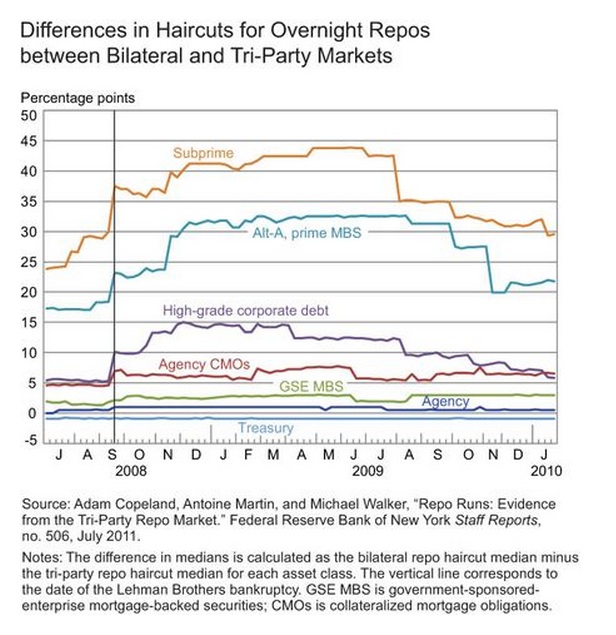On the FRBNY Liberty Street Economics blog there was post on Monday, September 17, 2012 entitled “The Odd Behavior of Repo Haircuts during the Financial Crisis” that caught our eye. This is a topic near and dear to us. The authors, Adam Copeland and Antoine Martin, are perplexed about the differences in haircuts on bilateral and tri-party repos during the financial crisis. We are not and it comes from first hand experience.
Copeland and Martin say that when comparing bilateral and tri-party repo, “The different behavior of haircuts in the bilateral and tri-party repo markets is puzzling. These two markets are similar, with both using the same contractual form and the same types of collateral. The purpose of some transactions in both markets is similar—market participants have stated that financial entities use the two markets for funding purposes. These two markets are also tightly linked; the larger securities dealers operate in both markets and often provide intermediation services by rehypothecating into the tri-party repo market collateral received via bilateral repos. These linkages suggest that haircut behavior across the two markets should be similar…”
They include an interesting chart showing the differences between haircuts on bilateral and tri-party repo just before and after the Lehman collapse.
Yes, the markets are tightly linked. But two major things must be remembered:
- Dealers use tri-party repos to fund themselves. As Copeland and Martin say, dealers often recycle assets taken in on bilateral repos by putting them out in tri-party. On non-UST/Agency asset classes, dealers will charge higher haircuts on bilateral reverse repos than they pay on tri-party repo simply as a good business practice. They can generate a credit cushion as well as create net liquidity. Sure, tri-party can be used to bring assets in (FICC trades on safe paper go both ways), but on the paper with the hair on it – subprime, Alt-A, corporate debt and to a lesser degree, agency CMOs – the flow is bilateral in, tri-party out. Some structured trades that finance client holdings of non-safe paper can use tri-party to facilitate the flow, but those haircuts look much more like bilateral trades. So no one should be surprised to see a haircut differential.
- More important is the nature of the tri-party trade negotiation and documentation process. Tri-party agreements, including the haircuts, are negotiated on master agreements. The haircuts are selected by asset type and hard wired into the clearing system. No one has the ability to change haircuts without going back to the lawyers. Dealers have no incentive to do this since it takes time and no one normally lowers hard-wired haircuts when renegotiating. Cash providers don’t risk manage their tri-party haircuts on a daily basis.
On bilateral deals, haircuts are negotiated trade by trade. Yes, there are market standard terms that are sticky, but in a crisis everything is off the table. On non-safe paper, in particular, it is not unusual for credit departments to approve haircuts on each and every bilateral deal, often driven by the latest volatility numbers.
The market can, in bilateral trading, release pressure by raising haircuts. There is a point when the haircuts get too high to make sense, prompting asset holders to deleverage. The structure of bilateral repo trading allows for the market to correct itself when risk changes. As others have noted, during the crisis, it was a slow motion run.
On tri-party trades, something else happens. Unable to rapidly change haircuts, the choice was to do the trade or not. No pressure value to be released – just yes or no. This is cliff risk in its purest form and, in our opinion, more dangerous and unpredictable that the adjustment process embedded in bilateral trades.
Some have written about the necessity to embrace fixed minimum haircuts in repo and that this will reduce risk. Minimums have a way of becoming maximums in finance markets. Unless those haircuts are so high as to be a catalyst for more deleveraging (which we don’t think is the objective) or legislated haircuts change very quickly (like margin requirements in futures markets), the cliff risk will not go away. In fact, it will be riskier since regulators will think they solved the problem and put it out of their minds. We are perplexed why regulators would consider hard haircuts, institutionalizing a bad practice.
A link to the post is here.


